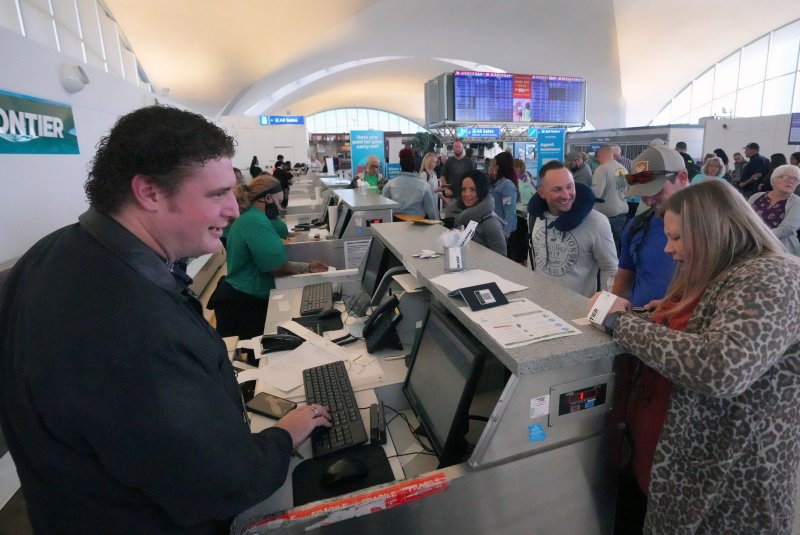1 of 3 | While road trips aren't yet back to pre-pandemic levels, AAA is expecting more people to fly the friendly skies this year for the long Memorial Day holiday weekend. File Photo by Bill Greenblatt/UPI |
License Photo
May 24 (UPI) -- Travel club AAA expects a bump in travel over Memorial Day weekend, although road trips have not bounced back to pre-pandemic levels despite sliding gas prices.
AAA said it projects 42.3 million Americans to travel 50 miles or more, up 2.7 million people, or 7%, from 2022.
"This is expected to be the third-busiest Memorial Day weekend since 2000, when AAA started tracking holiday travel," said Paula Twidale, a senior vice president at AAA's travel division.
AAA expects 6% more road trips over the coming holiday weekend than last year with some 37.1 million people expected to hit the road, taking advantage of a price at the pump that's $1.05 per gallon less than this time last year.
If traveling by bus or by train, don't expect a quick trip no matter where you're going. INRIX, which provides data on transportation, finds if you leave after noon Friday, don't expect smooth sailing. It's better to leave Thursday if you can, or wait until the actual weekend. And get up early on Monday because anything after 10 a.m. could be a nightmare.
"With lower fuel prices and more travelers on the road compared to last year, drivers should expect long delays this holiday weekend, especially in and around major metros as commuters mix with Memorial Day travelers," said Bob Pishue, a transportation analyst at INRIX. "Our advice is to avoid driving during peak hours or use alternative routes."
Meanwhile, air travel is expected to be 11% higher than last year and 5.4% more than pre-pandemic levels.
"Despite high ticket prices, demand for flights is skyrocketing," AAA said. "This Memorial Day weekend could be the busiest at airports since 2005."
High ticket prices do not reflect trends in the energy market, however. The latest reading on wholesale prices show jet fuel is on the decline and the International Air Transport Association finds prices are about 36% below year-ago levels.
Much of the increase in ticket prices, therefore, may be a reflection of a buildup in demand as air travel nearly evaporated during the pandemic. Some 2.5 million people moved through U.S. airport security on Monday, 9.5% higher than last year, 46% higher than in 2021 and 650% higher than that date in 2020, the start of the pandemic.
Patrick DeHaan, the lead petroleum analyst at Chicago-based GasBuddy, said people do plan to travel, though the majority had yet to make any definitive plans as of last week. What happens next "is contingent this year on the economy, debt ceiling discussions, and other factors, so it's a bit uncharted," he told UPI on Tuesday.
Confirming some of the pessimism, data show the expected amount of road trips this coming holiday weekend is actually below pre-pandemic levels. Ahead of Memorial Day in 2019, AAA's Twidale was pointing to things that seem like anomalies in the current market - consumer spending was strong and households had plenty of disposable cash to travel.
The "vast majority" of travelers in 2019 opted to hit the road, with 37.6 million travelers for the holiday -- the most on record.
Gas prices that year were around $2.80 per gallon, though they're close to current levels when adjusted for inflation. That, however, is a bit skewed given that inflationary strains have been apparent in the U.S. economy for the better part of a year.
Tom Kloza, the head of the Oil Price Information Service, said he's not expecting much movement for prices at the pump.
"Our base case is that we've probably seen the high-water mark for U.S. gas prices," he said.
A robust holiday travel season comes amid growing concerns about the fate of the U.S. economy. Inflation is on the decline, but still high at around 5% annually. Should the U.S. default on its debt obligations, meanwhile, inflation would skyrocket and put the global market into a tailspin.
And while on paper, demand looks to be holding up, it's coming at a cost. The Federal Reserve Bank of New York found total household debt is nearly $3 trillion more than 2019, before the onset of the COVID-19 pandemic.
Consumers are increasingly late on their debt payments. Delinquencies for credit cards increased by 0.6% and late payments on auto loans jumped by 0.2%, putting both figures above pre-pandemic levels.
Credit and auto-loan delinquencies increased more than any other type of debt, based on the percentage of debt payments that were more than 90 days late.
Phillip Jefferson, a governor at the Federal Reserve, said spending levels were moderating given the decline in consumer sentiment.
"While my base case forecast for the U.S. economy is not a recession, I expect spending and GDP growth to remain quite slow over the rest of 2023, due to continued tight financial conditions, low consumer sentiment, and a decline in household savings that had built up after the onset of the pandemic," he said.















